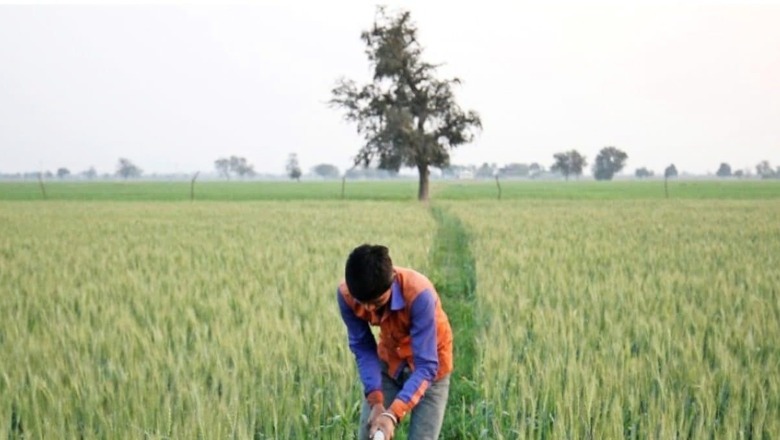
views
The weather this season has been unkind to farmers, especially as India has been hit with hailstorms, untimely rain and gusty winds over the past few weeks. Maharashtra, Rajasthan, Madhya Pradesh, Uttar Pradesh, etc have been hit and as a result, the Rabi harvests have suffered.
But before the rain and hailstorms came the heat waves, which primarily affected the onion farmers of Maharashtra. This led to a price fall and the quality of the onion being damaged. Rajasthan, too, reported heat trouble, affecting the mustard crop. Some areas even reported a loss of 30 percent of the mustard crop. Meanwhile, most of the mustard harvest finished before February end in North India, a rare event. Even Kashmir and Himachal experienced early shooting of fruit trees and faster melting of snow this year. Meanwhile, the coastal state of Kerala reported a heat index of reaching 54 C.
After the heat came the rain and hails, which have especially caused havoc in Madhya Pradesh. Wheat farmers were most affected in large parts of MP, which led Chief Minister Shivraj Chouhan to announce relief packages, extension of MSP wheat registration portal and a promise of covering climate-related damage through the crop insurance scheme. After Punjab and Haryana region, MP is also a major wheat-producing state and India was depending on MP for replenishing our strategic wheat reserves this season. But all plans seem to go haywire.
Taking stock of the weather, the Agriculture Minister launched the ‘Digiclaim’ application in six states, to ensure that farmers can now register claims and get Direct Benefit Transfers (DBTs) through their mobile phones. But more needs to be done because 2023 is not one odd year out, but rather a symptom of an agro-climatic transition. One only needs to compare the rainfall patterns and temperatures, matched by adverse weather events to say with a high probability that the conventional agro-climate is shifting. And we are in a transition phase. How long will this phase last before we achieve some stability and predictability, is hard to say. But as per traditional agriculture knowledge, the transitory period may last till 2027, if not more.
This can play more havoc on agriculture productivity and deeply impact farmers’ livelihoods, hence the need of the hour is to create a safety net for averting farm risks and ensuring the farmers are safeguarded, economically. This can be done through short and long-term policy interventions.
The first measure would be to ensure that we invest in creating the farmers’ and cultivars’ databases. Perhaps, open a portal for self-registration. Farmers and cultivars already receiving government subsidies and DBTs can automatically be registered. For the remaining ones, we can open up registration with financial incentives. Once the government has an approximate number of farmers and cultivars that may be affected by climate-related risks, we will be one step closer to the solution.
After the registry is created, the Government of India should move in, and if required, take the financial burden themselves and get crop insurance for vulnerable areas and farmers. The beneficiaries and regions can be changed depending on the forecasted climate events.
Ideally, all farmers should be covered under the crop insurance scheme. There is room for improvement within the crop insurance scheme too, for example, the inclusion of climate-related damages must be covered in the insurance schemes. More work is needed in claim assessment and settlement. But that is another matter. From the climate risk point of view, all farmers and all climate-related risks should be included in the scheme. Even if states cannot take the financial burden, the Centre should support it. Especially as it was reported that the agriculture ministry returned about Rs 44,000 crore to the government. Some of these resources would be enough to ensure some of the most vulnerable areas. Digiclaim should be expanded to all states to ensure affected farmers get some succour.
For unpredictable events, a Central government-supported farmers’ disaster relief fund could be a way to address climate relief exigencies.
Shifting gears to agriculture, we need to begin with the seed. As there is a conventional shift in seasons, we need newer seeds delivered to the farmers, either through public or private seed networks that can withstand the vagaries of the climate. India has an ample genetic diversity of cultivars which are still under-harnessed. Drought and flood-resistant seeds should be planted. Government seed recommendations and advisories should be put out in all regions. This can be easily achieved as there are agricultural officers in each district, who could coordinate this effort.
We need to get out of the genetic bottleneck of a few varieties and reintroduce genetic diversity in our fields. In extreme conditions leading to seed losses, district seed plans should be ready to provide farmers with seeds for re-sowing. A healthy stock of early, middle and late varieties should be maintained.
Now genetic diversity on an individual farm level builds climate resilience at a low cost to the farmers. Intercropping must be encouraged alongside intensive multi-cropping. Farmers must be encouraged to grow maybe 3-4 crops each season, and within the crops, use as many varieties as possible. The logic behind this step is, in case a couple of crops or sub-varieties get under the weather, the farmers will not lose their entire harvests, plus the nutrition per acre will not drop.
The government in the previous budget announced the creation of seed breeding villages. This program, if implemented well, will aid the fight against climate change. Local seed breeding programs can be a hub for climate resilient seeds which the regionally grown and farmers can access with ease at low costs.
The government is already trying very hard to push farmers away from paddy-wheat monocultures, but this drive needs a harder push backed by crop bonuses and public procurement. Paddy production is a water guzzler and also high on emissions, and yet India is spending a large part of our revenue in artificially subsidising this ecosystem. India already has surpluses, we need to ensure that greenhouse gas (GHG) emissions from agriculture reduce and land is allowed to heal. Millets, pulses, oilseeds and plantations offer a simple way to regain this balance and also save our forex reserves being spent on edible oil or fertiliser subsidies. These crops and some tree plantations are more resilient to climate threats and also aid in ecosystem restoration.
The changing climate also presents the problems of new pest attacks on crops. We have already seen the stem borer attacks across paddy regions and often the emergence of new suckling pests attacking all types of crops. The Agriculture department, along with other plant protection scientists need to be alert and have additional protocols and early warning systems. Farmers need to also be alert in advance of their region’s vulnerability. For if the pest breeding cycles begin, a gallon of pesticides will be wasted in preventing diseases and crop losses.
Weather forecasting is another aspect the government needs to look into. The technology is still nascent, and if it was not, we could have easily prevented the climate-related agrarian losses over the past couple of years. We can’t rely on it solely. Independent R&D is required, but in the meanwhile, the government needs to send weather alerts to farmers’ mobile phones. Because many farmers often complain that they never get weather notifications. Voluntary signup can be opened, and registered individuals can get extreme weather alerts on their mobiles. This would be good to curtail the damages or at least provide farmers with an early warning. For example, hailstorms are a new problem in fruit-growing areas of Kashmir. If farmers are given hail alerts, much of our Kashmiri apples, cherries, plums, etc can be saved.
Lastly, India needs to move towards organic agriculture. This is a long-term way of building resilience and climate-proofing our agrarian communities.
The author is an independent agri-policy analyst and former director – Policy and Outreach, National Seed Association of India. He tweets at @Indrassingh. Views are personal.
Read all the Latest Opinions here


















Comments
0 comment